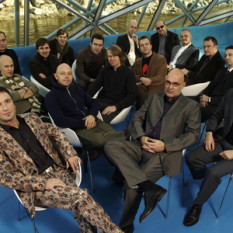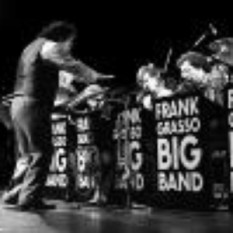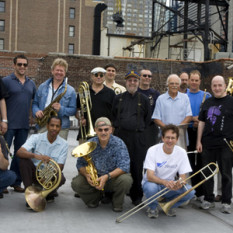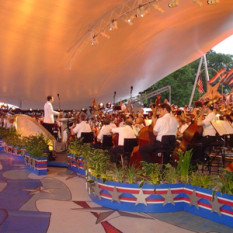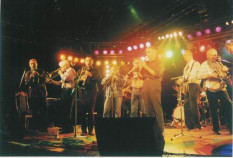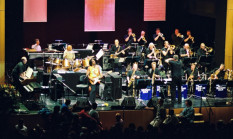Big Band describes an orchestral arrangement typically consisting of a reeds section of mostly saxophones (perhaps a featured clarinet), a brass section of trumpets and trombones (perhaps a featured cornet) and a rhythm section consisting of an upright bass, piano, rhythm guitars and a kit drummer. Reeds are very often two or more alto saxophones, two or more tenor saxophones (usually less than than number of altos) and at least one baritone sax; reed players may also double on clarinet, flute or soprano, but overall the section is dominated by altos and tenors.
The Big Band format grew out of the Dance Band traditions of the early 30's, themselves an outgrowth of the community Windbands, Concertbands and full Orchestras. Community orchestras often would have sub-units of musicians to fit each of these situations, but with the rise of radio, recording and the needs of the soldiers overseas, the Danceband format became more and more focussed on specific personalities and star players, leading to larger and larger venues wanting to see the superstars, and hence leading to an instrumentation sufficient to fill the large dancehall with a strong 'Swing' beat. With the decline of the Swing sound in the post-war years, many Big Bands turned to alternate 'exotic' instrumentation to keep their music interesting; Sun Ra added african percussion, Les Baxter added strings and tropical rhythms, Gil Evans nearly added Jimi Hendrix :)
Big Bands today still keep quite close to the original instrumentation although bands today are largely determined by who is available rather than by the demands of the scores. The music today can also range from strictly Swing to Free-Jazz (e.g. Carla Bley) to Third Stream (Gunter Schuller, Charles Mingus) to just about anything goes (Dave Matthews, Darcy Argue) and still fall into the realm of 'Big Band' .

